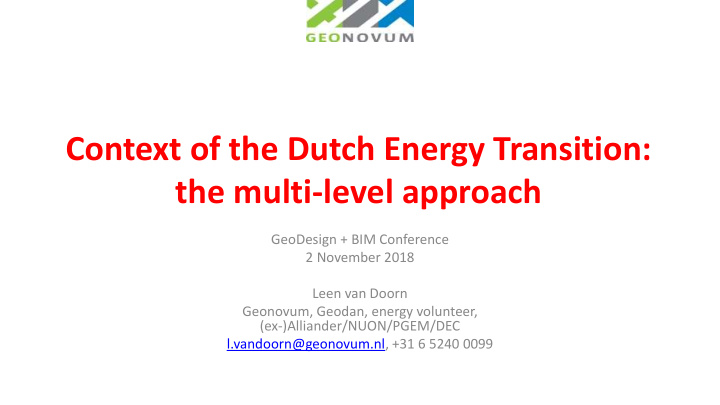



Context of the Dutch Energy Transition: the multi-level approach GeoDesign + BIM Conference 2 November 2018 Leen van Doorn Geonovum, Geodan, energy volunteer, (ex-)Alliander/NUON/PGEM/DEC l.vandoorn@geonovum.nl, +31 6 5240 0099
Breakfast, today
Framework of this talk • drivers for change and challenges • the future – a centralist approach • the future – a decentralist approach • the past of energy supply • energy transition • trend: polycentric governance • energy and spatial information
Drivers for change ... stable core values • reliable : more robust infrastructure, fuel security • affordable : EU: liberalisation unbundling, energy markets • clean : environmental consequences, climate change recent developments • “ polycentric governance of climate change” : Paris / EU / country / province / region / township / neighborhood / streets / individual citizens and companies • the energetic society / knowledgeable citizens / pro-active businesses / bottom-up • in he Netherlands: National Energy/Climate Agreement (2013, 2018/2019) • lower costs for renewable energy production and energy storage (electricity, heat) • earthquakes in the province of Groningen due to gas extraction • desire for autarky and small scale – just like IT/internet (mainframes -> PC’s ) • electrification of energy supply (heat, transport, chemical industry, mobility, etc.) • crucial role for IT and data (Internet of Energy)
... leading to opinions, opinions The press and newsletters: • the energy system must be based on sustainable gases : green gas, hydrogen • windturbines at the North Sea • first insulate all houses because otherwise heat pumps will consume too much electriciy for the grid • with geothermics and aquathermics we can heat all houses • batteries will never be cheap enough for residential use • carbon capture and storage (CCS) is impossible • carbon capture and usage (CCU) is a necessary • we need multifuel-plants (biomass co-firing) • biomass should be used for food, and for energy as last resort • etc. etc.
One view is: a centralist way ...
This so- called ‘North Sea Wind Power Hub’ has the potential to supply 70 to 100 million Europeans with renewable energy by 2050
Largest PV-project in Europe (2017) (Fr, Bordeaux, 300 MW, 250 ha) China : The Longyangxia Dam Solar Park is the largest in the world (850 MW).
... vs. the decentralist way Some developments: • 8 mln energy plants in NL ( the connected home ) • every surface as solar plants (residential areas, facades, public infrastructure, public land and water) • residential heat pumps, wood ovens, small heating grids • every electric vehicle as energy buffer ( the connected car ) • energy trade peer-to-peer • the neighborhood as energy system • citizens as co-owner of local energy systems
BIPV (Building Integrated PV), www.bipvnederland.nl https://www.ecn.nl/news/item/du tch-solar-design-facade-module- optimises-appearance-yield-and- sustainability/
So: How to interpret this plethora of opinions that all sincerely address the road towards a new energy system? A framework to clarify this complicated matter is very welcome!
Energy supply – looking back large scale, top-down, vertically integrated, (super)specialists, “ sleep well, we plan the world, we watch over you and we think for you; this all for just the cost price plus 4%”
Energy transition • Transitions address problems that are: complex / broad societal / persistent • Definition of transitions (Rotmans, 2000) A structural societal transformation , that is the result of interlinked and interacting developments on economics, culture, technologies, institutions and nature & environment A precondition for transitions is that change takes place at the level of systems. A system being a coherent framework of elements that influence each other in a certain direction.
Multi-level perspective on technological transitions (Geels, Energy Policy 2002)
Examples of ‘regime - thinking’ • Trend towards decentralisation (both energy system as well as governance), but the regime maintains centralist and large scale thinking: – Energy Odyssea (25.000 wind turbines Noordzee) – a strong focus on flexibility and period without wind & sun , “ so the traditional power plants remain needed for backups ” • Legislation is many years behind, e.g. – impossibility of inter-citizen trade of energy – double taxation of energy storage • Illustration: forecasts by IEA, based on energy policies from ‘regime’ actors
IEA: the established (fossil) world
Examples of niches The Netherlands: Germany: local sustainable coops ownership of renewable production
The result of this transition will be a continuously changing energysystem
... where detailed spatial analyses are necessary in an already crowded landscape; analyses for wind ...
... for solar energy (PV and heat), and more.
Thus spatial analyses with multi- stakeholder interactions are here to stay! The next speakers will dive into different aspects of geodesign. Thank you for your attention!
Recommend
More recommend